Business Law Case Study: Examining Governance in ArcelorMittal Merger
VerifiedAdded on 2023/04/25
|10
|2737
|424
Case Study
AI Summary
This case study examines the Arcelor and Mittal merger in 2006, focusing on the corporate governance aspects and the implications under business law. The merger resulted in ArcelorMittal, the world’s largest steel plant, with a shift from Arcelor's two-tier board structure to a unitary board structure dominated by the Mittal family. The study discusses the advantages and disadvantages of this unitary board, particularly concerning decision-making efficiency versus potential conflicts of interest and the limited influence of minority shareholders and institutional investors. It also analyzes the voting rights distribution, where the Mittal family retained a significant majority, impacting the governance and control of the company. The analysis further assesses the impact of this board structure on management, shareholder protection, and overall corporate governance, highlighting potential issues of transparency and minority shareholder representation. Desklib offers a wide array of solved assignments and past papers for students.
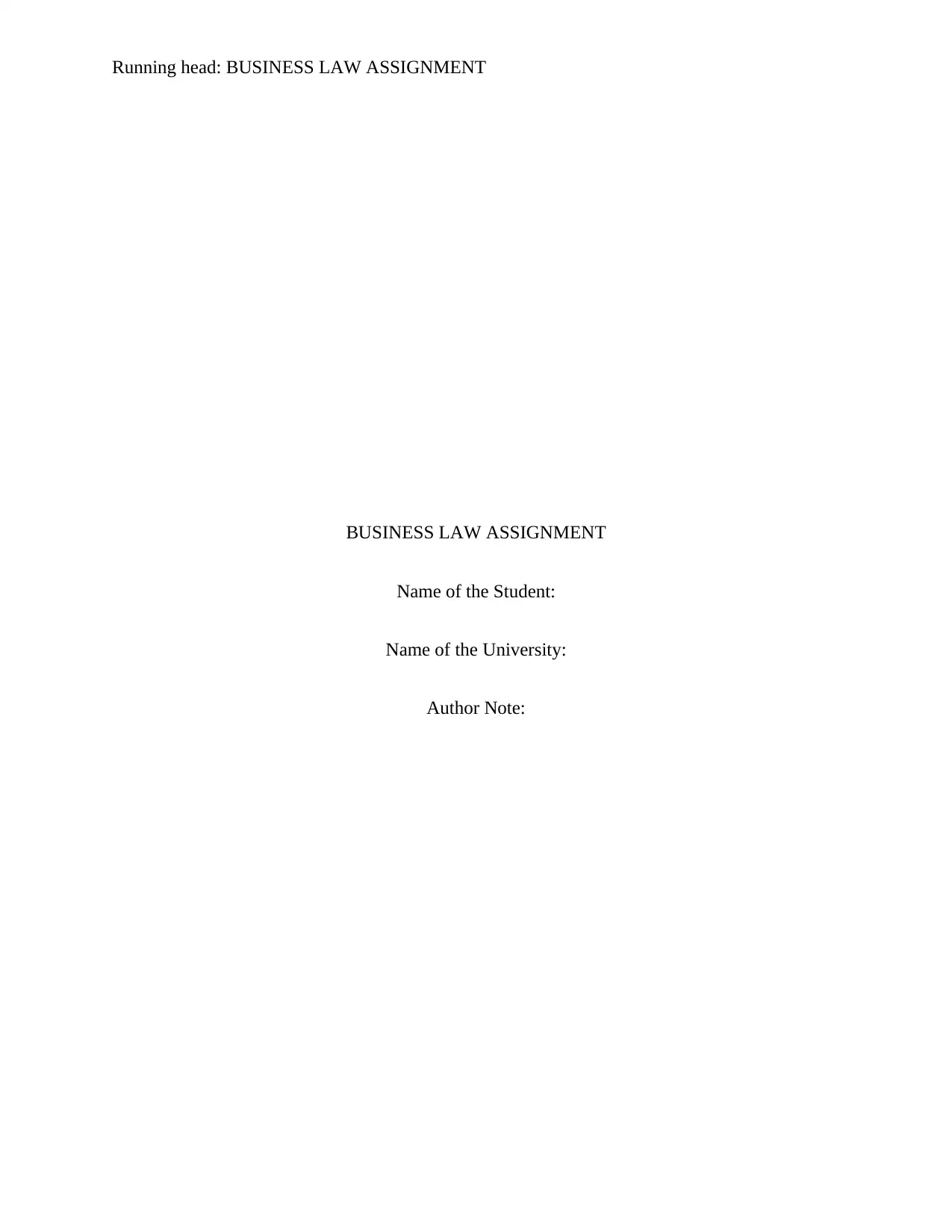
Running head: BUSINESS LAW ASSIGNMENT
BUSINESS LAW ASSIGNMENT
Name of the Student:
Name of the University:
Author Note:
BUSINESS LAW ASSIGNMENT
Name of the Student:
Name of the University:
Author Note:
Paraphrase This Document
Need a fresh take? Get an instant paraphrase of this document with our AI Paraphraser
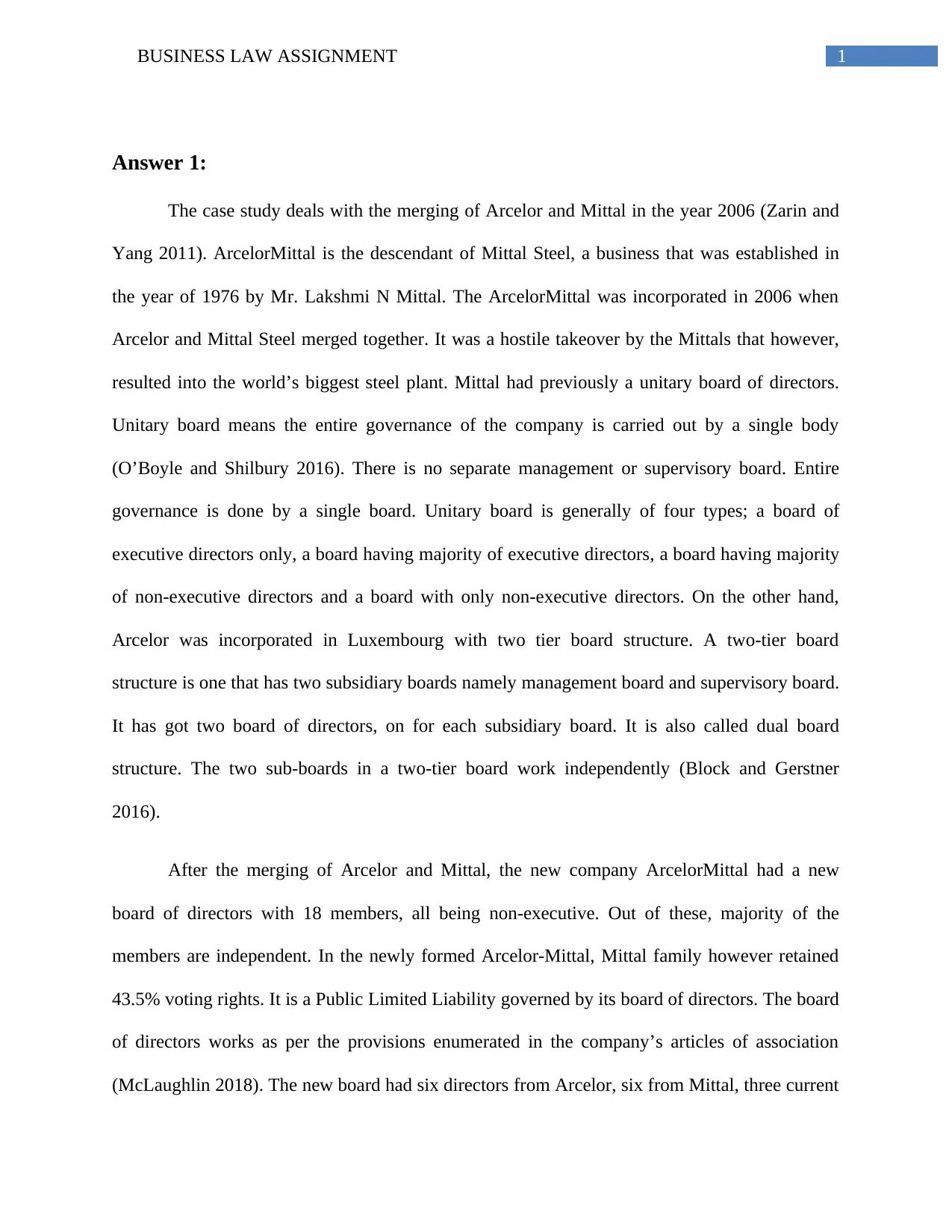
1BUSINESS LAW ASSIGNMENT
Answer 1:
The case study deals with the merging of Arcelor and Mittal in the year 2006 (Zarin and
Yang 2011). ArcelorMittal is the descendant of Mittal Steel, a business that was established in
the year of 1976 by Mr. Lakshmi N Mittal. The ArcelorMittal was incorporated in 2006 when
Arcelor and Mittal Steel merged together. It was a hostile takeover by the Mittals that however,
resulted into the world’s biggest steel plant. Mittal had previously a unitary board of directors.
Unitary board means the entire governance of the company is carried out by a single body
(O’Boyle and Shilbury 2016). There is no separate management or supervisory board. Entire
governance is done by a single board. Unitary board is generally of four types; a board of
executive directors only, a board having majority of executive directors, a board having majority
of non-executive directors and a board with only non-executive directors. On the other hand,
Arcelor was incorporated in Luxembourg with two tier board structure. A two-tier board
structure is one that has two subsidiary boards namely management board and supervisory board.
It has got two board of directors, on for each subsidiary board. It is also called dual board
structure. The two sub-boards in a two-tier board work independently (Block and Gerstner
2016).
After the merging of Arcelor and Mittal, the new company ArcelorMittal had a new
board of directors with 18 members, all being non-executive. Out of these, majority of the
members are independent. In the newly formed Arcelor-Mittal, Mittal family however retained
43.5% voting rights. It is a Public Limited Liability governed by its board of directors. The board
of directors works as per the provisions enumerated in the company’s articles of association
(McLaughlin 2018). The new board had six directors from Arcelor, six from Mittal, three current
Answer 1:
The case study deals with the merging of Arcelor and Mittal in the year 2006 (Zarin and
Yang 2011). ArcelorMittal is the descendant of Mittal Steel, a business that was established in
the year of 1976 by Mr. Lakshmi N Mittal. The ArcelorMittal was incorporated in 2006 when
Arcelor and Mittal Steel merged together. It was a hostile takeover by the Mittals that however,
resulted into the world’s biggest steel plant. Mittal had previously a unitary board of directors.
Unitary board means the entire governance of the company is carried out by a single body
(O’Boyle and Shilbury 2016). There is no separate management or supervisory board. Entire
governance is done by a single board. Unitary board is generally of four types; a board of
executive directors only, a board having majority of executive directors, a board having majority
of non-executive directors and a board with only non-executive directors. On the other hand,
Arcelor was incorporated in Luxembourg with two tier board structure. A two-tier board
structure is one that has two subsidiary boards namely management board and supervisory board.
It has got two board of directors, on for each subsidiary board. It is also called dual board
structure. The two sub-boards in a two-tier board work independently (Block and Gerstner
2016).
After the merging of Arcelor and Mittal, the new company ArcelorMittal had a new
board of directors with 18 members, all being non-executive. Out of these, majority of the
members are independent. In the newly formed Arcelor-Mittal, Mittal family however retained
43.5% voting rights. It is a Public Limited Liability governed by its board of directors. The board
of directors works as per the provisions enumerated in the company’s articles of association
(McLaughlin 2018). The new board had six directors from Arcelor, six from Mittal, three current
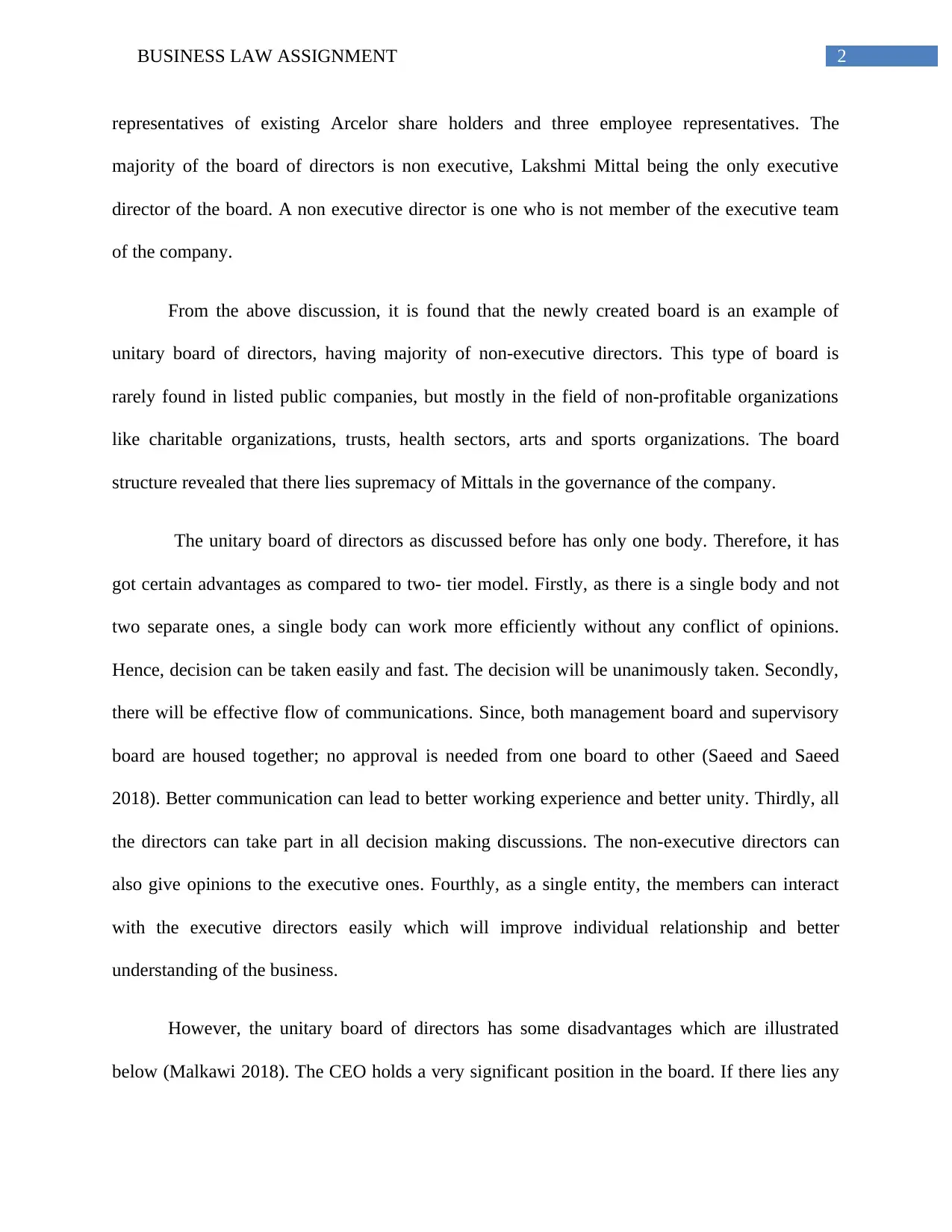
2BUSINESS LAW ASSIGNMENT
representatives of existing Arcelor share holders and three employee representatives. The
majority of the board of directors is non executive, Lakshmi Mittal being the only executive
director of the board. A non executive director is one who is not member of the executive team
of the company.
From the above discussion, it is found that the newly created board is an example of
unitary board of directors, having majority of non-executive directors. This type of board is
rarely found in listed public companies, but mostly in the field of non-profitable organizations
like charitable organizations, trusts, health sectors, arts and sports organizations. The board
structure revealed that there lies supremacy of Mittals in the governance of the company.
The unitary board of directors as discussed before has only one body. Therefore, it has
got certain advantages as compared to two- tier model. Firstly, as there is a single body and not
two separate ones, a single body can work more efficiently without any conflict of opinions.
Hence, decision can be taken easily and fast. The decision will be unanimously taken. Secondly,
there will be effective flow of communications. Since, both management board and supervisory
board are housed together; no approval is needed from one board to other (Saeed and Saeed
2018). Better communication can lead to better working experience and better unity. Thirdly, all
the directors can take part in all decision making discussions. The non-executive directors can
also give opinions to the executive ones. Fourthly, as a single entity, the members can interact
with the executive directors easily which will improve individual relationship and better
understanding of the business.
However, the unitary board of directors has some disadvantages which are illustrated
below (Malkawi 2018). The CEO holds a very significant position in the board. If there lies any
representatives of existing Arcelor share holders and three employee representatives. The
majority of the board of directors is non executive, Lakshmi Mittal being the only executive
director of the board. A non executive director is one who is not member of the executive team
of the company.
From the above discussion, it is found that the newly created board is an example of
unitary board of directors, having majority of non-executive directors. This type of board is
rarely found in listed public companies, but mostly in the field of non-profitable organizations
like charitable organizations, trusts, health sectors, arts and sports organizations. The board
structure revealed that there lies supremacy of Mittals in the governance of the company.
The unitary board of directors as discussed before has only one body. Therefore, it has
got certain advantages as compared to two- tier model. Firstly, as there is a single body and not
two separate ones, a single body can work more efficiently without any conflict of opinions.
Hence, decision can be taken easily and fast. The decision will be unanimously taken. Secondly,
there will be effective flow of communications. Since, both management board and supervisory
board are housed together; no approval is needed from one board to other (Saeed and Saeed
2018). Better communication can lead to better working experience and better unity. Thirdly, all
the directors can take part in all decision making discussions. The non-executive directors can
also give opinions to the executive ones. Fourthly, as a single entity, the members can interact
with the executive directors easily which will improve individual relationship and better
understanding of the business.
However, the unitary board of directors has some disadvantages which are illustrated
below (Malkawi 2018). The CEO holds a very significant position in the board. If there lies any
⊘ This is a preview!⊘
Do you want full access?
Subscribe today to unlock all pages.

Trusted by 1+ million students worldwide
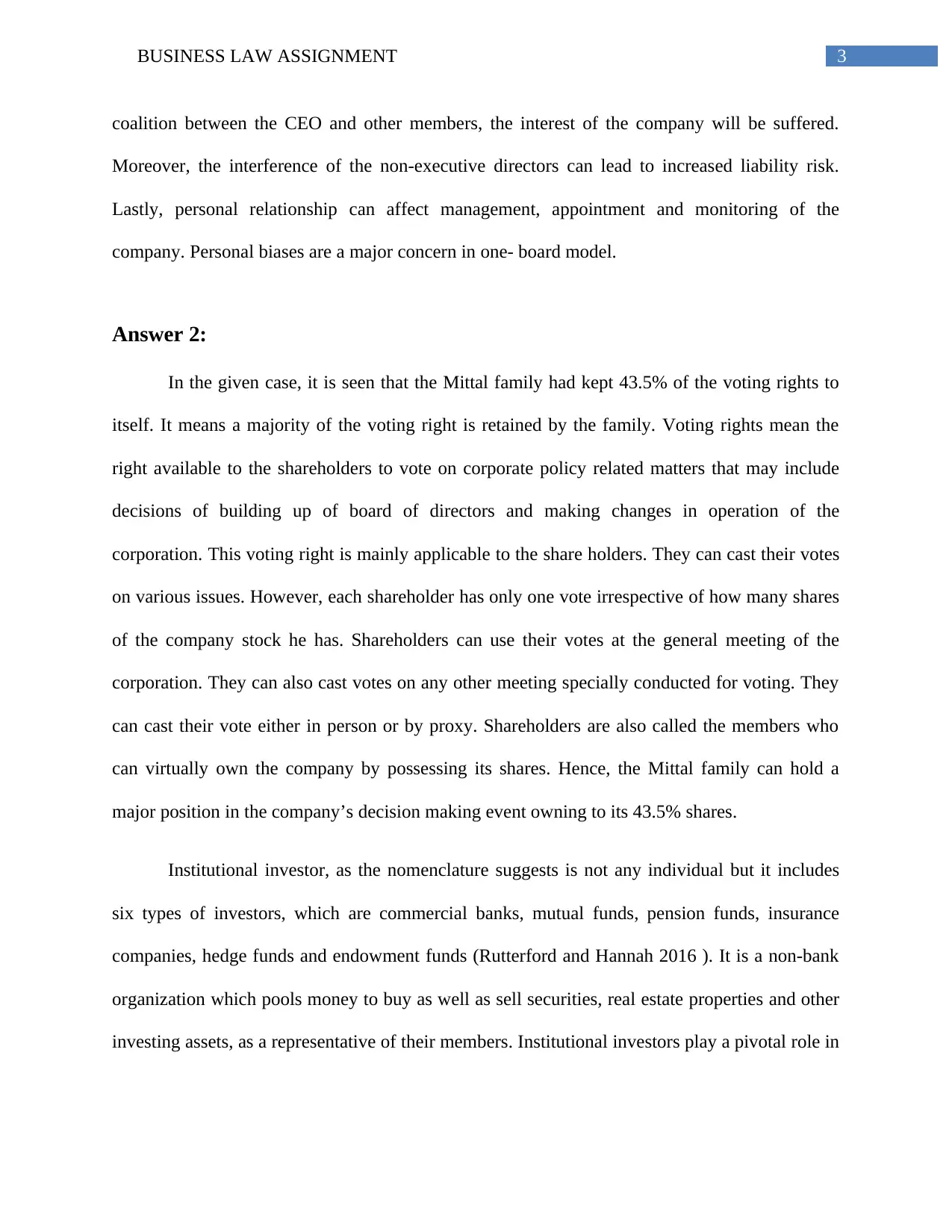
3BUSINESS LAW ASSIGNMENT
coalition between the CEO and other members, the interest of the company will be suffered.
Moreover, the interference of the non-executive directors can lead to increased liability risk.
Lastly, personal relationship can affect management, appointment and monitoring of the
company. Personal biases are a major concern in one- board model.
Answer 2:
In the given case, it is seen that the Mittal family had kept 43.5% of the voting rights to
itself. It means a majority of the voting right is retained by the family. Voting rights mean the
right available to the shareholders to vote on corporate policy related matters that may include
decisions of building up of board of directors and making changes in operation of the
corporation. This voting right is mainly applicable to the share holders. They can cast their votes
on various issues. However, each shareholder has only one vote irrespective of how many shares
of the company stock he has. Shareholders can use their votes at the general meeting of the
corporation. They can also cast votes on any other meeting specially conducted for voting. They
can cast their vote either in person or by proxy. Shareholders are also called the members who
can virtually own the company by possessing its shares. Hence, the Mittal family can hold a
major position in the company’s decision making event owning to its 43.5% shares.
Institutional investor, as the nomenclature suggests is not any individual but it includes
six types of investors, which are commercial banks, mutual funds, pension funds, insurance
companies, hedge funds and endowment funds (Rutterford and Hannah 2016 ). It is a non-bank
organization which pools money to buy as well as sell securities, real estate properties and other
investing assets, as a representative of their members. Institutional investors play a pivotal role in
coalition between the CEO and other members, the interest of the company will be suffered.
Moreover, the interference of the non-executive directors can lead to increased liability risk.
Lastly, personal relationship can affect management, appointment and monitoring of the
company. Personal biases are a major concern in one- board model.
Answer 2:
In the given case, it is seen that the Mittal family had kept 43.5% of the voting rights to
itself. It means a majority of the voting right is retained by the family. Voting rights mean the
right available to the shareholders to vote on corporate policy related matters that may include
decisions of building up of board of directors and making changes in operation of the
corporation. This voting right is mainly applicable to the share holders. They can cast their votes
on various issues. However, each shareholder has only one vote irrespective of how many shares
of the company stock he has. Shareholders can use their votes at the general meeting of the
corporation. They can also cast votes on any other meeting specially conducted for voting. They
can cast their vote either in person or by proxy. Shareholders are also called the members who
can virtually own the company by possessing its shares. Hence, the Mittal family can hold a
major position in the company’s decision making event owning to its 43.5% shares.
Institutional investor, as the nomenclature suggests is not any individual but it includes
six types of investors, which are commercial banks, mutual funds, pension funds, insurance
companies, hedge funds and endowment funds (Rutterford and Hannah 2016 ). It is a non-bank
organization which pools money to buy as well as sell securities, real estate properties and other
investing assets, as a representative of their members. Institutional investors play a pivotal role in
Paraphrase This Document
Need a fresh take? Get an instant paraphrase of this document with our AI Paraphraser
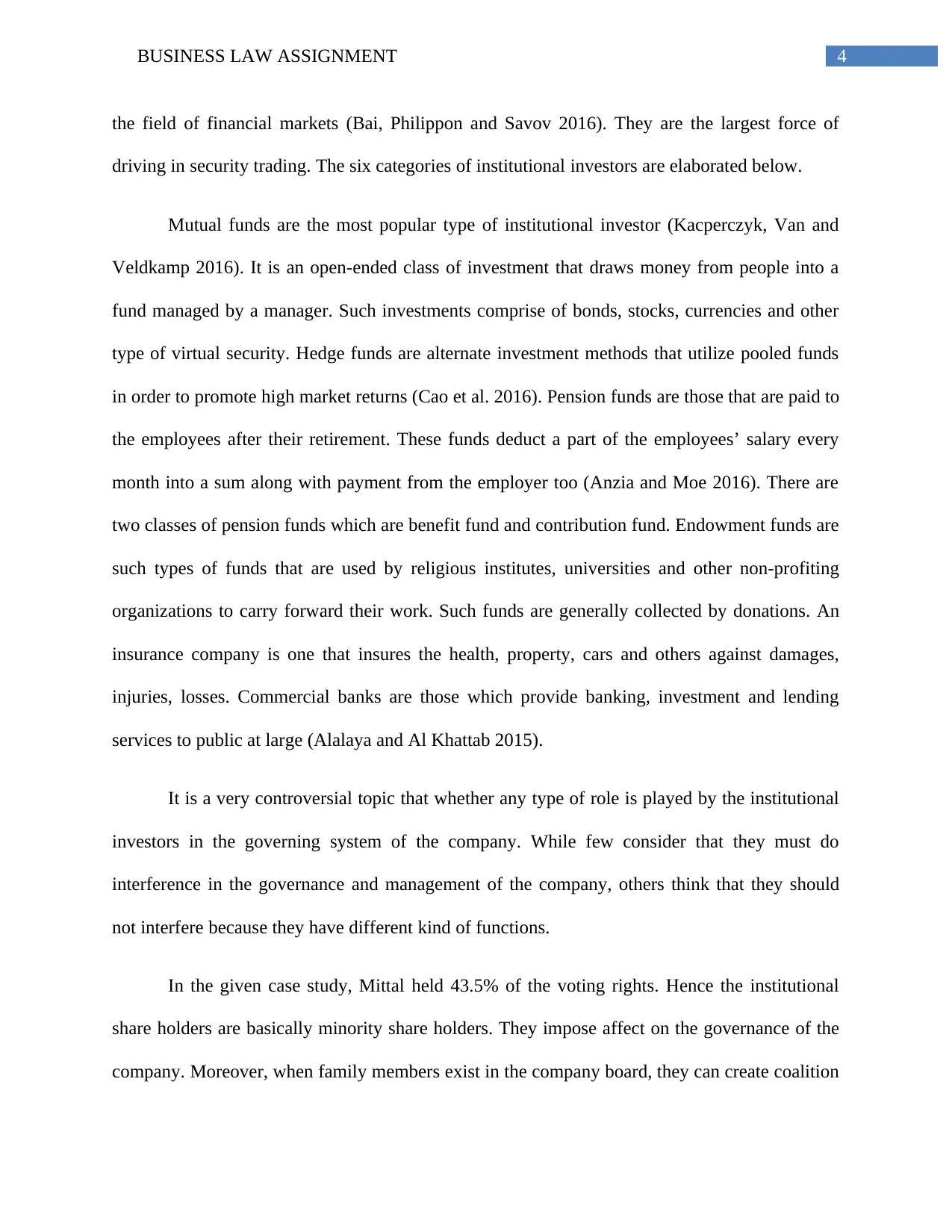
4BUSINESS LAW ASSIGNMENT
the field of financial markets (Bai, Philippon and Savov 2016). They are the largest force of
driving in security trading. The six categories of institutional investors are elaborated below.
Mutual funds are the most popular type of institutional investor (Kacperczyk, Van and
Veldkamp 2016). It is an open-ended class of investment that draws money from people into a
fund managed by a manager. Such investments comprise of bonds, stocks, currencies and other
type of virtual security. Hedge funds are alternate investment methods that utilize pooled funds
in order to promote high market returns (Cao et al. 2016). Pension funds are those that are paid to
the employees after their retirement. These funds deduct a part of the employees’ salary every
month into a sum along with payment from the employer too (Anzia and Moe 2016). There are
two classes of pension funds which are benefit fund and contribution fund. Endowment funds are
such types of funds that are used by religious institutes, universities and other non-profiting
organizations to carry forward their work. Such funds are generally collected by donations. An
insurance company is one that insures the health, property, cars and others against damages,
injuries, losses. Commercial banks are those which provide banking, investment and lending
services to public at large (Alalaya and Al Khattab 2015).
It is a very controversial topic that whether any type of role is played by the institutional
investors in the governing system of the company. While few consider that they must do
interference in the governance and management of the company, others think that they should
not interfere because they have different kind of functions.
In the given case study, Mittal held 43.5% of the voting rights. Hence the institutional
share holders are basically minority share holders. They impose affect on the governance of the
company. Moreover, when family members exist in the company board, they can create coalition
the field of financial markets (Bai, Philippon and Savov 2016). They are the largest force of
driving in security trading. The six categories of institutional investors are elaborated below.
Mutual funds are the most popular type of institutional investor (Kacperczyk, Van and
Veldkamp 2016). It is an open-ended class of investment that draws money from people into a
fund managed by a manager. Such investments comprise of bonds, stocks, currencies and other
type of virtual security. Hedge funds are alternate investment methods that utilize pooled funds
in order to promote high market returns (Cao et al. 2016). Pension funds are those that are paid to
the employees after their retirement. These funds deduct a part of the employees’ salary every
month into a sum along with payment from the employer too (Anzia and Moe 2016). There are
two classes of pension funds which are benefit fund and contribution fund. Endowment funds are
such types of funds that are used by religious institutes, universities and other non-profiting
organizations to carry forward their work. Such funds are generally collected by donations. An
insurance company is one that insures the health, property, cars and others against damages,
injuries, losses. Commercial banks are those which provide banking, investment and lending
services to public at large (Alalaya and Al Khattab 2015).
It is a very controversial topic that whether any type of role is played by the institutional
investors in the governing system of the company. While few consider that they must do
interference in the governance and management of the company, others think that they should
not interfere because they have different kind of functions.
In the given case study, Mittal held 43.5% of the voting rights. Hence the institutional
share holders are basically minority share holders. They impose affect on the governance of the
company. Moreover, when family members exist in the company board, they can create coalition
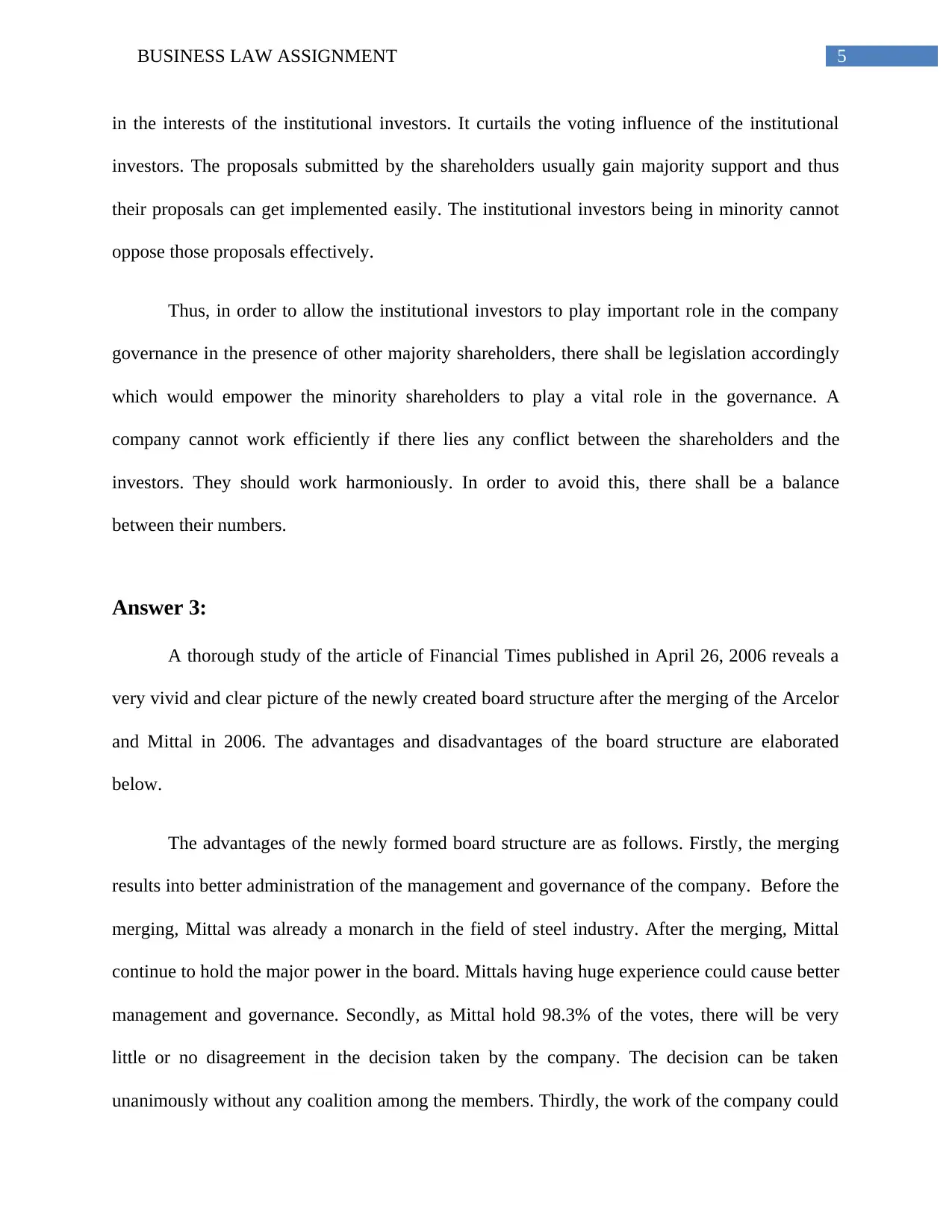
5BUSINESS LAW ASSIGNMENT
in the interests of the institutional investors. It curtails the voting influence of the institutional
investors. The proposals submitted by the shareholders usually gain majority support and thus
their proposals can get implemented easily. The institutional investors being in minority cannot
oppose those proposals effectively.
Thus, in order to allow the institutional investors to play important role in the company
governance in the presence of other majority shareholders, there shall be legislation accordingly
which would empower the minority shareholders to play a vital role in the governance. A
company cannot work efficiently if there lies any conflict between the shareholders and the
investors. They should work harmoniously. In order to avoid this, there shall be a balance
between their numbers.
Answer 3:
A thorough study of the article of Financial Times published in April 26, 2006 reveals a
very vivid and clear picture of the newly created board structure after the merging of the Arcelor
and Mittal in 2006. The advantages and disadvantages of the board structure are elaborated
below.
The advantages of the newly formed board structure are as follows. Firstly, the merging
results into better administration of the management and governance of the company. Before the
merging, Mittal was already a monarch in the field of steel industry. After the merging, Mittal
continue to hold the major power in the board. Mittals having huge experience could cause better
management and governance. Secondly, as Mittal hold 98.3% of the votes, there will be very
little or no disagreement in the decision taken by the company. The decision can be taken
unanimously without any coalition among the members. Thirdly, the work of the company could
in the interests of the institutional investors. It curtails the voting influence of the institutional
investors. The proposals submitted by the shareholders usually gain majority support and thus
their proposals can get implemented easily. The institutional investors being in minority cannot
oppose those proposals effectively.
Thus, in order to allow the institutional investors to play important role in the company
governance in the presence of other majority shareholders, there shall be legislation accordingly
which would empower the minority shareholders to play a vital role in the governance. A
company cannot work efficiently if there lies any conflict between the shareholders and the
investors. They should work harmoniously. In order to avoid this, there shall be a balance
between their numbers.
Answer 3:
A thorough study of the article of Financial Times published in April 26, 2006 reveals a
very vivid and clear picture of the newly created board structure after the merging of the Arcelor
and Mittal in 2006. The advantages and disadvantages of the board structure are elaborated
below.
The advantages of the newly formed board structure are as follows. Firstly, the merging
results into better administration of the management and governance of the company. Before the
merging, Mittal was already a monarch in the field of steel industry. After the merging, Mittal
continue to hold the major power in the board. Mittals having huge experience could cause better
management and governance. Secondly, as Mittal hold 98.3% of the votes, there will be very
little or no disagreement in the decision taken by the company. The decision can be taken
unanimously without any coalition among the members. Thirdly, the work of the company could
⊘ This is a preview!⊘
Do you want full access?
Subscribe today to unlock all pages.

Trusted by 1+ million students worldwide
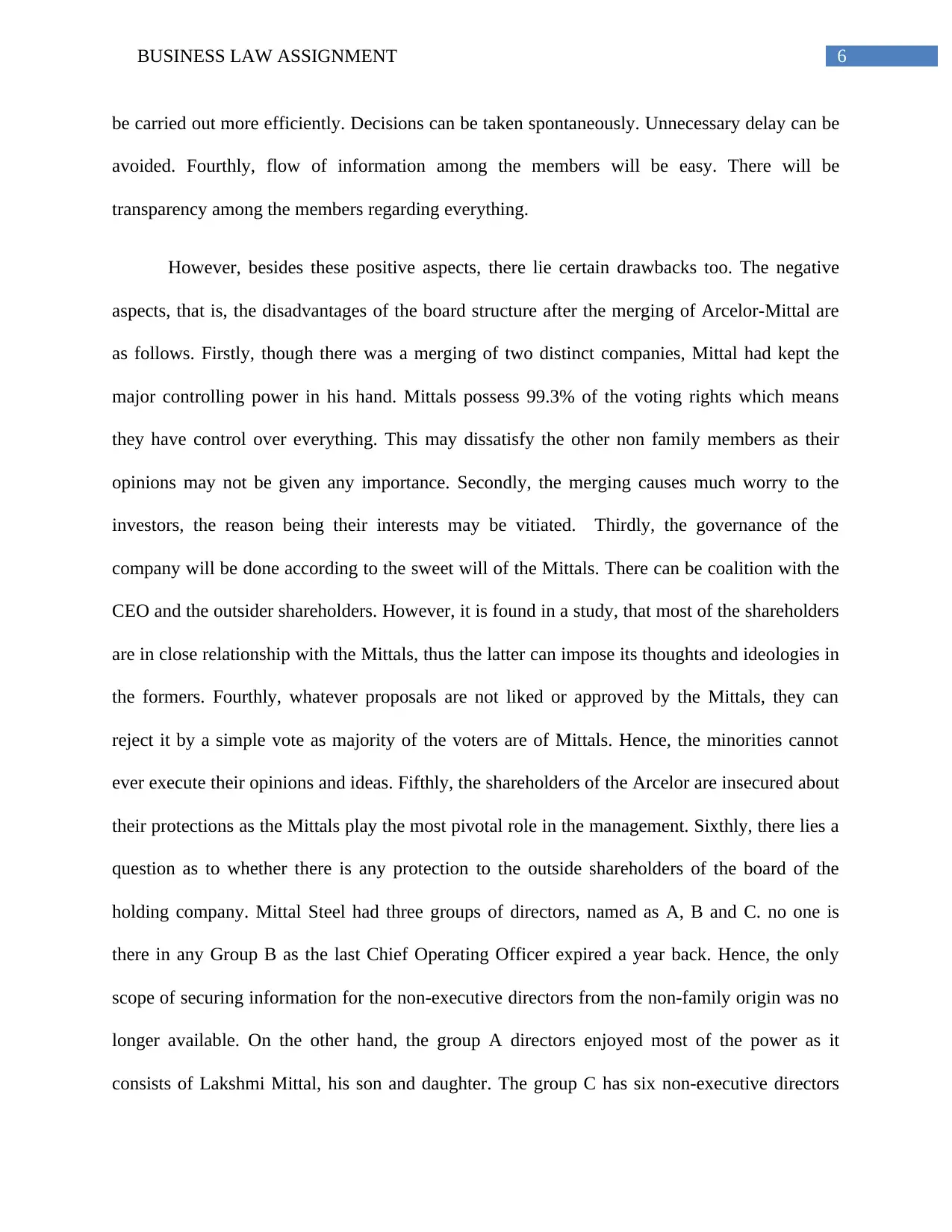
6BUSINESS LAW ASSIGNMENT
be carried out more efficiently. Decisions can be taken spontaneously. Unnecessary delay can be
avoided. Fourthly, flow of information among the members will be easy. There will be
transparency among the members regarding everything.
However, besides these positive aspects, there lie certain drawbacks too. The negative
aspects, that is, the disadvantages of the board structure after the merging of Arcelor-Mittal are
as follows. Firstly, though there was a merging of two distinct companies, Mittal had kept the
major controlling power in his hand. Mittals possess 99.3% of the voting rights which means
they have control over everything. This may dissatisfy the other non family members as their
opinions may not be given any importance. Secondly, the merging causes much worry to the
investors, the reason being their interests may be vitiated. Thirdly, the governance of the
company will be done according to the sweet will of the Mittals. There can be coalition with the
CEO and the outsider shareholders. However, it is found in a study, that most of the shareholders
are in close relationship with the Mittals, thus the latter can impose its thoughts and ideologies in
the formers. Fourthly, whatever proposals are not liked or approved by the Mittals, they can
reject it by a simple vote as majority of the voters are of Mittals. Hence, the minorities cannot
ever execute their opinions and ideas. Fifthly, the shareholders of the Arcelor are insecured about
their protections as the Mittals play the most pivotal role in the management. Sixthly, there lies a
question as to whether there is any protection to the outside shareholders of the board of the
holding company. Mittal Steel had three groups of directors, named as A, B and C. no one is
there in any Group B as the last Chief Operating Officer expired a year back. Hence, the only
scope of securing information for the non-executive directors from the non-family origin was no
longer available. On the other hand, the group A directors enjoyed most of the power as it
consists of Lakshmi Mittal, his son and daughter. The group C has six non-executive directors
be carried out more efficiently. Decisions can be taken spontaneously. Unnecessary delay can be
avoided. Fourthly, flow of information among the members will be easy. There will be
transparency among the members regarding everything.
However, besides these positive aspects, there lie certain drawbacks too. The negative
aspects, that is, the disadvantages of the board structure after the merging of Arcelor-Mittal are
as follows. Firstly, though there was a merging of two distinct companies, Mittal had kept the
major controlling power in his hand. Mittals possess 99.3% of the voting rights which means
they have control over everything. This may dissatisfy the other non family members as their
opinions may not be given any importance. Secondly, the merging causes much worry to the
investors, the reason being their interests may be vitiated. Thirdly, the governance of the
company will be done according to the sweet will of the Mittals. There can be coalition with the
CEO and the outsider shareholders. However, it is found in a study, that most of the shareholders
are in close relationship with the Mittals, thus the latter can impose its thoughts and ideologies in
the formers. Fourthly, whatever proposals are not liked or approved by the Mittals, they can
reject it by a simple vote as majority of the voters are of Mittals. Hence, the minorities cannot
ever execute their opinions and ideas. Fifthly, the shareholders of the Arcelor are insecured about
their protections as the Mittals play the most pivotal role in the management. Sixthly, there lies a
question as to whether there is any protection to the outside shareholders of the board of the
holding company. Mittal Steel had three groups of directors, named as A, B and C. no one is
there in any Group B as the last Chief Operating Officer expired a year back. Hence, the only
scope of securing information for the non-executive directors from the non-family origin was no
longer available. On the other hand, the group A directors enjoyed most of the power as it
consists of Lakshmi Mittal, his son and daughter. The group C has six non-executive directors
Paraphrase This Document
Need a fresh take? Get an instant paraphrase of this document with our AI Paraphraser
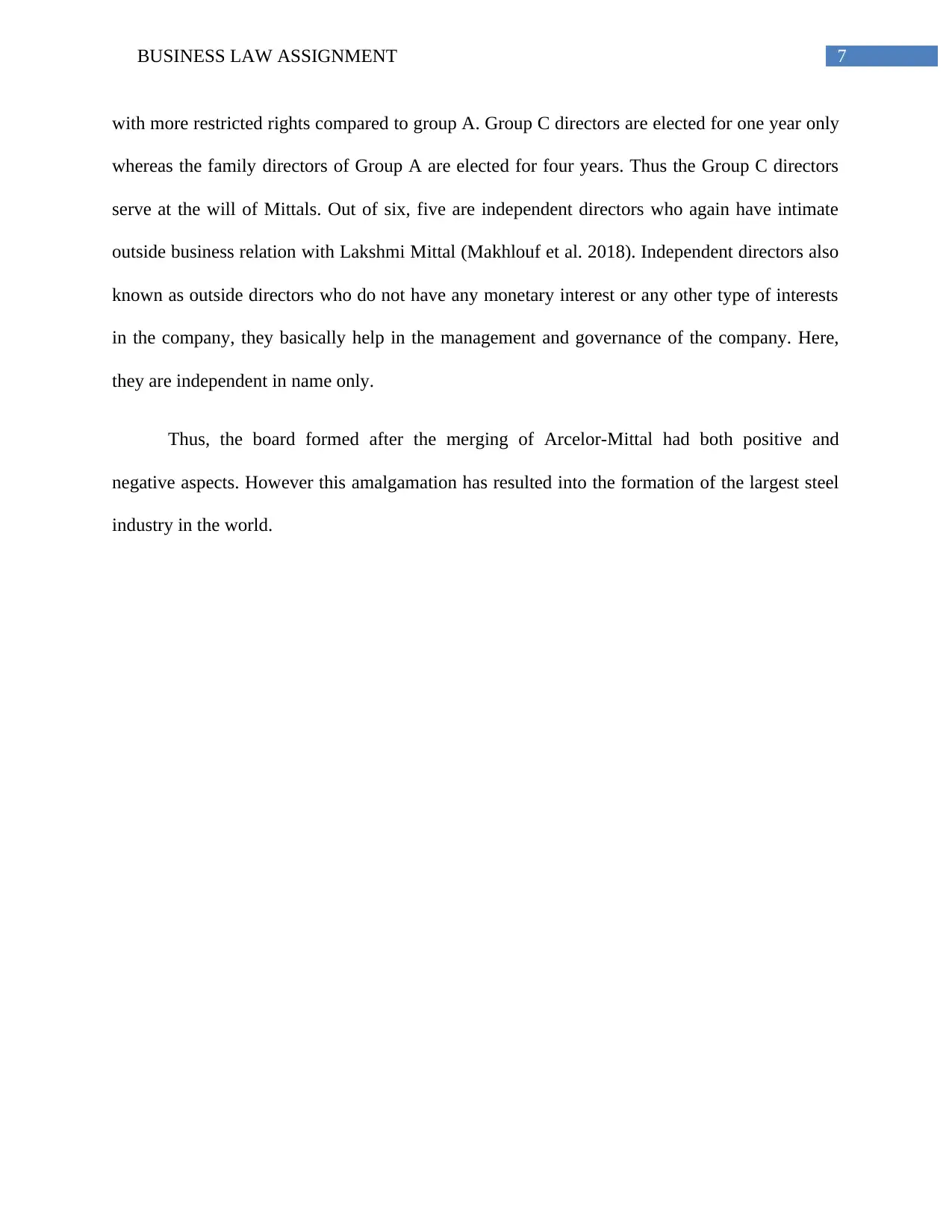
7BUSINESS LAW ASSIGNMENT
with more restricted rights compared to group A. Group C directors are elected for one year only
whereas the family directors of Group A are elected for four years. Thus the Group C directors
serve at the will of Mittals. Out of six, five are independent directors who again have intimate
outside business relation with Lakshmi Mittal (Makhlouf et al. 2018). Independent directors also
known as outside directors who do not have any monetary interest or any other type of interests
in the company, they basically help in the management and governance of the company. Here,
they are independent in name only.
Thus, the board formed after the merging of Arcelor-Mittal had both positive and
negative aspects. However this amalgamation has resulted into the formation of the largest steel
industry in the world.
with more restricted rights compared to group A. Group C directors are elected for one year only
whereas the family directors of Group A are elected for four years. Thus the Group C directors
serve at the will of Mittals. Out of six, five are independent directors who again have intimate
outside business relation with Lakshmi Mittal (Makhlouf et al. 2018). Independent directors also
known as outside directors who do not have any monetary interest or any other type of interests
in the company, they basically help in the management and governance of the company. Here,
they are independent in name only.
Thus, the board formed after the merging of Arcelor-Mittal had both positive and
negative aspects. However this amalgamation has resulted into the formation of the largest steel
industry in the world.
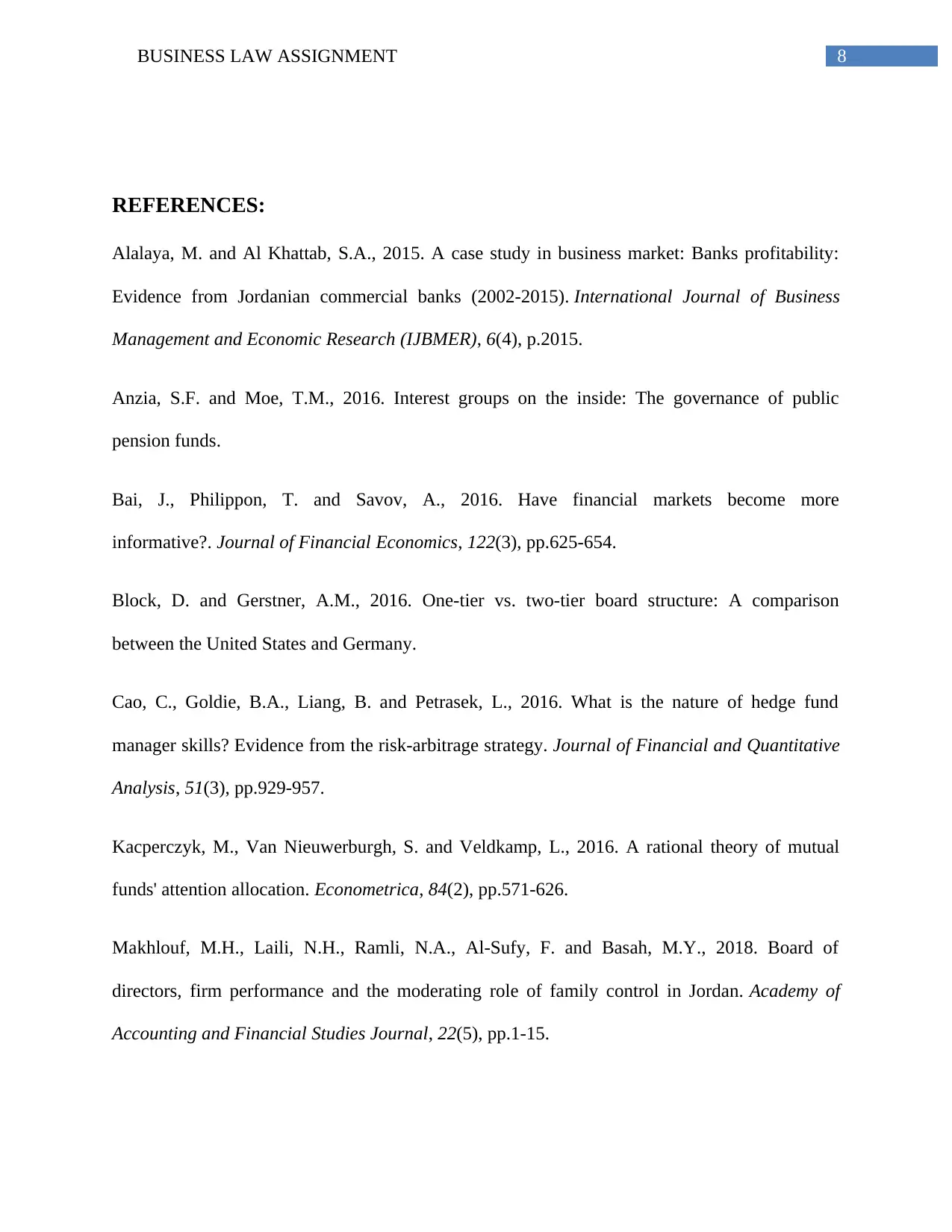
8BUSINESS LAW ASSIGNMENT
REFERENCES:
Alalaya, M. and Al Khattab, S.A., 2015. A case study in business market: Banks profitability:
Evidence from Jordanian commercial banks (2002-2015). International Journal of Business
Management and Economic Research (IJBMER), 6(4), p.2015.
Anzia, S.F. and Moe, T.M., 2016. Interest groups on the inside: The governance of public
pension funds.
Bai, J., Philippon, T. and Savov, A., 2016. Have financial markets become more
informative?. Journal of Financial Economics, 122(3), pp.625-654.
Block, D. and Gerstner, A.M., 2016. One-tier vs. two-tier board structure: A comparison
between the United States and Germany.
Cao, C., Goldie, B.A., Liang, B. and Petrasek, L., 2016. What is the nature of hedge fund
manager skills? Evidence from the risk-arbitrage strategy. Journal of Financial and Quantitative
Analysis, 51(3), pp.929-957.
Kacperczyk, M., Van Nieuwerburgh, S. and Veldkamp, L., 2016. A rational theory of mutual
funds' attention allocation. Econometrica, 84(2), pp.571-626.
Makhlouf, M.H., Laili, N.H., Ramli, N.A., Al-Sufy, F. and Basah, M.Y., 2018. Board of
directors, firm performance and the moderating role of family control in Jordan. Academy of
Accounting and Financial Studies Journal, 22(5), pp.1-15.
REFERENCES:
Alalaya, M. and Al Khattab, S.A., 2015. A case study in business market: Banks profitability:
Evidence from Jordanian commercial banks (2002-2015). International Journal of Business
Management and Economic Research (IJBMER), 6(4), p.2015.
Anzia, S.F. and Moe, T.M., 2016. Interest groups on the inside: The governance of public
pension funds.
Bai, J., Philippon, T. and Savov, A., 2016. Have financial markets become more
informative?. Journal of Financial Economics, 122(3), pp.625-654.
Block, D. and Gerstner, A.M., 2016. One-tier vs. two-tier board structure: A comparison
between the United States and Germany.
Cao, C., Goldie, B.A., Liang, B. and Petrasek, L., 2016. What is the nature of hedge fund
manager skills? Evidence from the risk-arbitrage strategy. Journal of Financial and Quantitative
Analysis, 51(3), pp.929-957.
Kacperczyk, M., Van Nieuwerburgh, S. and Veldkamp, L., 2016. A rational theory of mutual
funds' attention allocation. Econometrica, 84(2), pp.571-626.
Makhlouf, M.H., Laili, N.H., Ramli, N.A., Al-Sufy, F. and Basah, M.Y., 2018. Board of
directors, firm performance and the moderating role of family control in Jordan. Academy of
Accounting and Financial Studies Journal, 22(5), pp.1-15.
⊘ This is a preview!⊘
Do you want full access?
Subscribe today to unlock all pages.

Trusted by 1+ million students worldwide
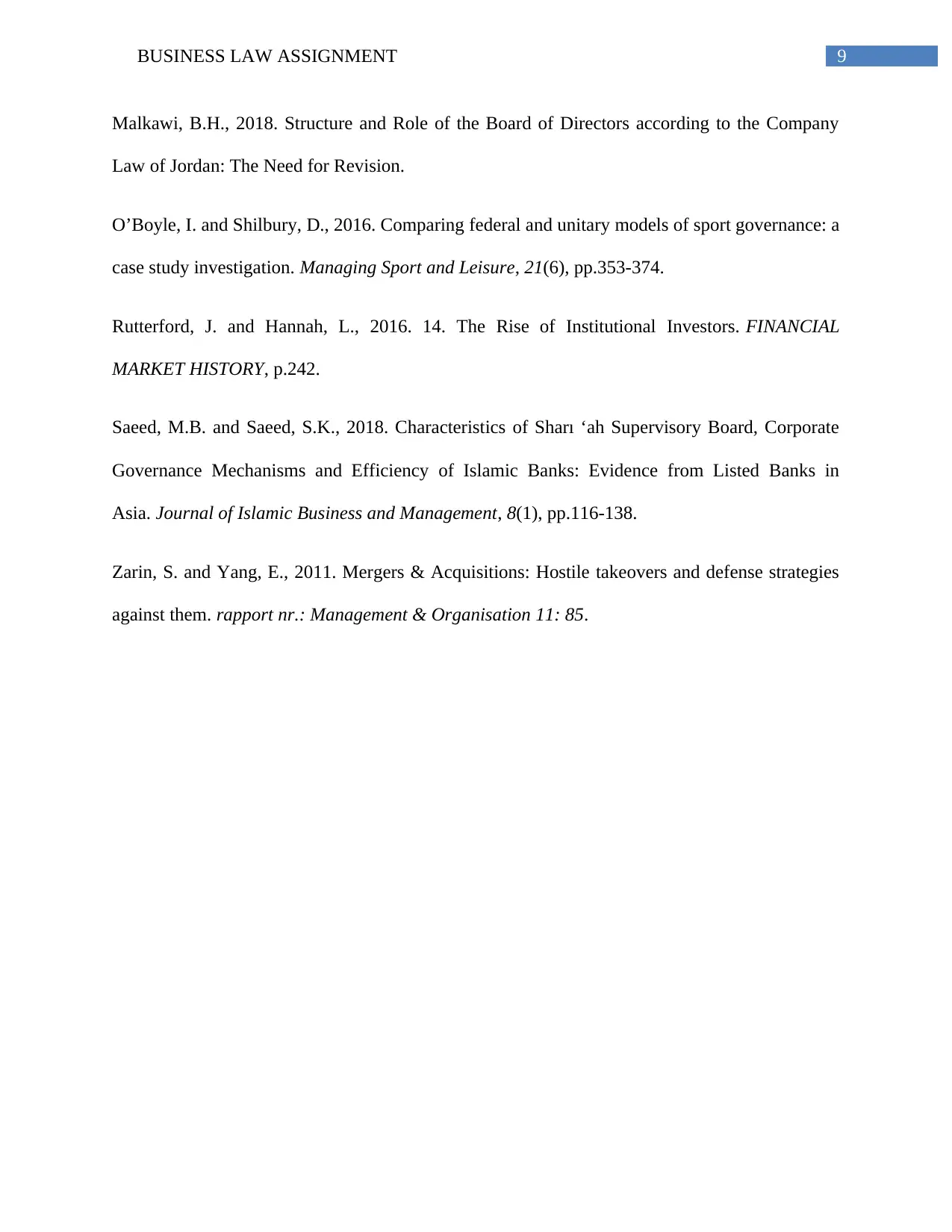
9BUSINESS LAW ASSIGNMENT
Malkawi, B.H., 2018. Structure and Role of the Board of Directors according to the Company
Law of Jordan: The Need for Revision.
O’Boyle, I. and Shilbury, D., 2016. Comparing federal and unitary models of sport governance: a
case study investigation. Managing Sport and Leisure, 21(6), pp.353-374.
Rutterford, J. and Hannah, L., 2016. 14. The Rise of Institutional Investors. FINANCIAL
MARKET HISTORY, p.242.
Saeed, M.B. and Saeed, S.K., 2018. Characteristics of Sharı ‘ah Supervisory Board, Corporate
Governance Mechanisms and Efficiency of Islamic Banks: Evidence from Listed Banks in
Asia. Journal of Islamic Business and Management, 8(1), pp.116-138.
Zarin, S. and Yang, E., 2011. Mergers & Acquisitions: Hostile takeovers and defense strategies
against them. rapport nr.: Management & Organisation 11: 85.
Malkawi, B.H., 2018. Structure and Role of the Board of Directors according to the Company
Law of Jordan: The Need for Revision.
O’Boyle, I. and Shilbury, D., 2016. Comparing federal and unitary models of sport governance: a
case study investigation. Managing Sport and Leisure, 21(6), pp.353-374.
Rutterford, J. and Hannah, L., 2016. 14. The Rise of Institutional Investors. FINANCIAL
MARKET HISTORY, p.242.
Saeed, M.B. and Saeed, S.K., 2018. Characteristics of Sharı ‘ah Supervisory Board, Corporate
Governance Mechanisms and Efficiency of Islamic Banks: Evidence from Listed Banks in
Asia. Journal of Islamic Business and Management, 8(1), pp.116-138.
Zarin, S. and Yang, E., 2011. Mergers & Acquisitions: Hostile takeovers and defense strategies
against them. rapport nr.: Management & Organisation 11: 85.
1 out of 10
Related Documents
Your All-in-One AI-Powered Toolkit for Academic Success.
+13062052269
info@desklib.com
Available 24*7 on WhatsApp / Email
![[object Object]](/_next/static/media/star-bottom.7253800d.svg)
Unlock your academic potential
Copyright © 2020–2025 A2Z Services. All Rights Reserved. Developed and managed by ZUCOL.





